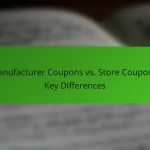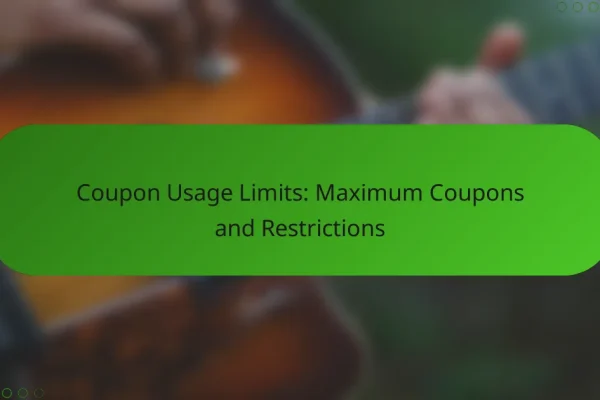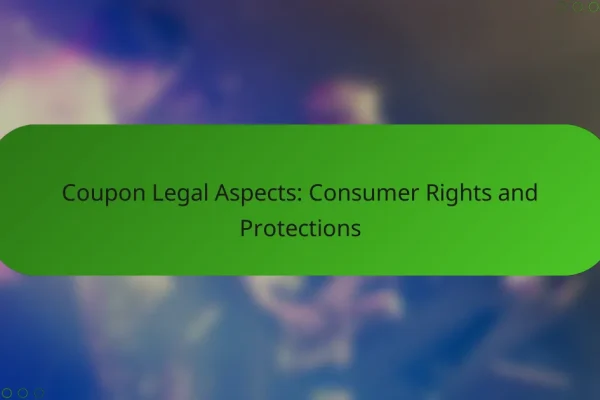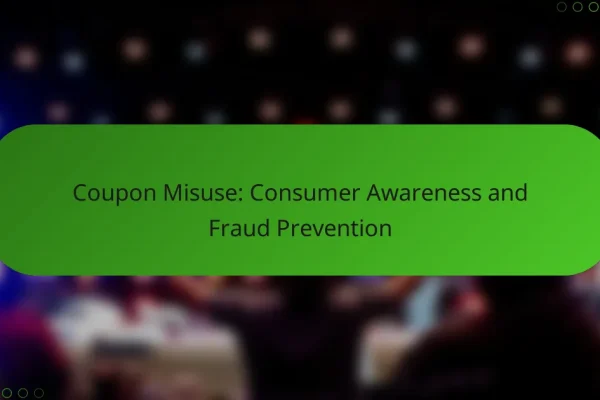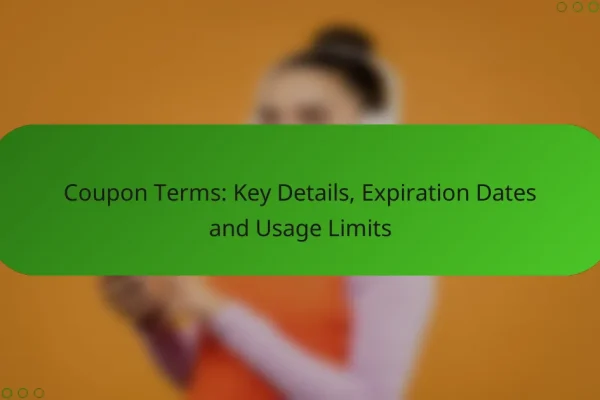What are common coupon terms and conditions?
Common coupon terms and conditions outline the rules and limitations associated with using coupons. These terms help consumers understand how to effectively use coupons while ensuring compliance with the retailer’s policies.
Expiration dates
Expiration dates indicate the last day a coupon can be used. Coupons typically have a validity period ranging from a few weeks to several months, so it’s crucial to check these dates before attempting to redeem them.
Using a coupon past its expiration date usually results in it being rejected at checkout. Always plan your purchases around these dates to maximize savings.
Usage limits
Usage limits specify how many times a coupon can be redeemed by a single customer or within a specific timeframe. For instance, a coupon might be valid for one use per transaction or limited to a certain number of redemptions per household.
Understanding these limits can prevent disappointment at checkout. Always read the fine print to know how many times you can use a coupon.
Eligible products
Eligible products refer to the specific items that a coupon can be applied to. Coupons often apply to select brands or product categories, so it’s essential to verify which items qualify.
For example, a coupon for a discount on laundry detergent may only apply to specific brands. Check the terms to ensure your intended purchase is eligible for the discount.
Exclusions
Exclusions are items or categories that are not eligible for coupon discounts. Common exclusions include sale items, clearance products, or specific brands that the coupon does not cover.
Being aware of exclusions can save time and prevent frustration at checkout. Always review the exclusions to avoid surprises when redeeming your coupon.
Redemption procedures
Redemption procedures outline the steps required to use a coupon effectively. This may include showing the coupon at checkout, entering a code online, or meeting minimum purchase requirements.
For online shopping, ensure you enter the coupon code correctly during checkout. In-store, present the coupon to the cashier before completing the transaction to ensure the discount is applied.
How do coupon terms affect consumer behavior?
Coupon terms significantly influence consumer behavior by shaping perceptions of value and urgency. Clear terms can enhance trust and encourage purchases, while complex conditions may deter potential buyers.
Influence on purchasing decisions
Coupon terms directly impact purchasing decisions by creating a sense of urgency and perceived savings. For example, limited-time offers can prompt consumers to buy immediately rather than wait, potentially increasing sales during promotional periods.
Additionally, straightforward terms, such as “20% off your next purchase,” are more likely to motivate consumers compared to complicated conditions. Consumers often prefer deals that are easy to understand and apply, which can lead to higher conversion rates.
Impact on brand loyalty
Clear and favorable coupon terms can enhance brand loyalty by fostering positive consumer experiences. When customers feel they receive genuine value from a brand’s promotions, they are more likely to return for future purchases.
On the other hand, misleading or overly restrictive coupon terms can damage trust and drive customers away. Brands should aim to maintain transparency in their offers to build long-lasting relationships with their customers.
What are the legal requirements for coupon terms?
Legal requirements for coupon terms ensure that promotions are clear, truthful, and not misleading. These regulations help protect consumers by requiring businesses to provide essential information about the offer, including expiration dates, restrictions, and conditions for use.
Truth in advertising laws
Truth in advertising laws mandate that all promotional materials, including coupons, must be truthful and not deceptive. Businesses must accurately represent the value of the coupon and any limitations that apply. For instance, if a coupon offers a discount, it should clearly state whether it applies to all products or only specific items.
Failure to comply with these laws can result in penalties, including fines and legal action. Companies should regularly review their advertising practices to ensure they meet these standards.
State-specific regulations
In addition to federal laws, many states have their own regulations governing coupon promotions. These state-specific rules can vary significantly, affecting how coupons are distributed and redeemed. For example, some states may require additional disclosures about the terms of the offer.
Businesses should familiarize themselves with the regulations in each state where they operate. This may include understanding local consumer protection laws and ensuring that coupon terms comply with those requirements. Regular audits of promotional materials can help identify potential compliance issues before they arise.
How can businesses create effective coupon terms?
Businesses can create effective coupon terms by ensuring they are clear, concise, and tailored to their target audience. This involves outlining the rules and limitations in a straightforward manner to avoid confusion and enhance customer satisfaction.
Clarity and transparency
Clarity and transparency are crucial in coupon terms to build trust with customers. Clearly state the discount amount, expiration date, and any restrictions, such as minimum purchase requirements or specific product applicability. For example, a coupon that offers “20% off your next purchase of $50 or more” is straightforward and easy to understand.
Transparency also involves being upfront about any exclusions. If certain items are not eligible for the discount, list them explicitly to prevent customer frustration. This practice can lead to a better shopping experience and reduce the likelihood of disputes.
Target audience considerations
Understanding the target audience is essential when crafting coupon terms. Different demographics may respond better to various incentives, so tailor the language and offers accordingly. For instance, younger consumers might prefer digital coupons with instant savings, while older customers may appreciate traditional paper coupons with clear instructions.
Additionally, consider the purchasing behavior of your audience. If your customers often buy in bulk, a coupon offering a discount on larger quantities may be more appealing. Conducting surveys or analyzing past sales data can help identify the most effective coupon strategies for your specific market segment.
What are the best practices for displaying coupon terms?
Best practices for displaying coupon terms focus on clarity and accessibility. Clear visibility and easy access to terms help users understand the conditions attached to the coupon, enhancing their shopping experience.
Visibility on promotional materials
Coupon terms should be prominently displayed on all promotional materials, including websites, emails, and printed advertisements. Use a font size that is easily readable and ensure the text contrasts well with the background for better visibility.
Consider placing the terms near the coupon code or offer details to ensure users see them together. For example, if advertising a 20% discount, include the terms directly below the promotional message to avoid confusion.
Accessibility for users
Ensure that coupon terms are accessible to all users, including those with disabilities. Use descriptive alt text for images and ensure that the text is compatible with screen readers. This promotes inclusivity and compliance with accessibility standards.
Additionally, consider providing a downloadable PDF version of the terms for users who prefer to read offline. This can be particularly useful for complex offers that require detailed explanations.
How do coupon terms vary by industry?
Coupon terms can differ significantly across various industries, impacting how consumers use them. Factors such as expiration dates, redemption processes, and restrictions often vary based on whether the coupon is for retail or service sectors.
Retail vs. service industries
In the retail industry, coupons typically offer discounts on products and may have specific terms regarding minimum purchase amounts or exclusions on certain items. For example, a grocery store might issue a coupon that provides $5 off a $25 purchase, while excluding sale items.
Service industries, such as salons or repair services, often use coupons to attract new customers or encourage repeat business. These coupons may include terms like “first visit only” or “not valid on weekends,” which can limit when and how they can be used. Understanding these distinctions is crucial for consumers to maximize their savings.
Digital vs. print coupons
Digital coupons are increasingly popular and often come with terms that specify how they can be redeemed, such as needing to show the coupon on a mobile device or entering a code online. Many retailers offer exclusive digital discounts that may not be available in print.
Print coupons, on the other hand, usually require physical presentation at the point of sale. They may have terms that include expiration dates and limitations on usage, such as “one coupon per transaction.” Consumers should be aware of these differences to ensure they follow the correct redemption process and avoid missing out on savings.
What are emerging trends in coupon terms and conditions?
Emerging trends in coupon terms and conditions reflect a shift towards greater transparency and consumer protection. Businesses are increasingly adopting clearer language and more straightforward rules to enhance customer trust and compliance with regulations.
Increased Transparency
Many companies are simplifying their coupon terms to make them more understandable. This includes using plain language and avoiding legal jargon, which helps consumers easily grasp the conditions attached to discounts. For example, instead of stating “valid on select items only,” businesses might specify “not applicable on clearance items,” clarifying the limitations.
Digital and Mobile Coupons
The rise of digital and mobile coupons has led to new terms and conditions that cater to online shopping behaviors. These coupons often include expiration dates, usage limits, and specific platforms where they can be redeemed. For instance, a mobile coupon might be valid only through a specific app, requiring users to be aware of where and how to use it.
Personalization and Targeting
Personalized coupons are becoming more common, with terms that reflect individual consumer behavior and preferences. Businesses may offer tailored discounts based on past purchases or browsing history, which can lead to more effective marketing strategies. However, this trend raises privacy concerns, making it essential for companies to clearly outline how customer data is used in their terms.
Regulatory Compliance
As consumer protection laws evolve, businesses must ensure their coupon terms comply with relevant regulations. This includes adhering to advertising standards and ensuring that terms are not misleading. In the U.S., for example, the Federal Trade Commission (FTC) requires that all terms be clearly disclosed to avoid deceptive practices.



